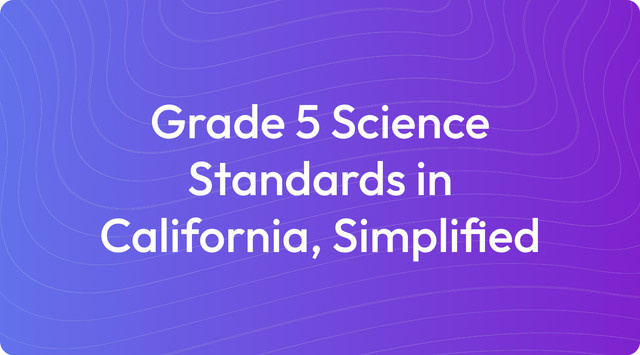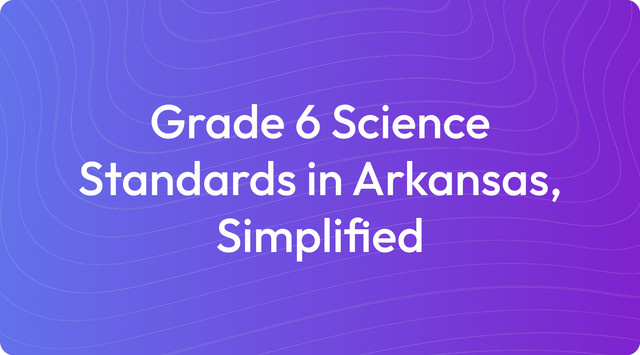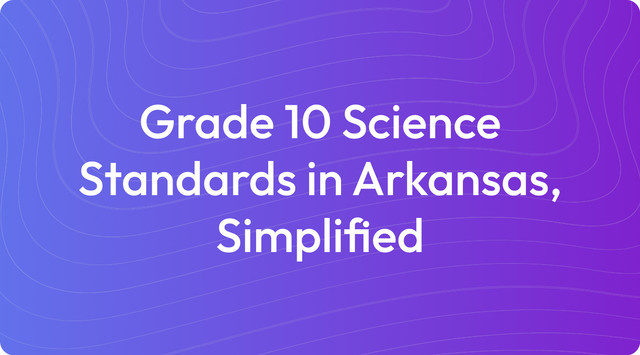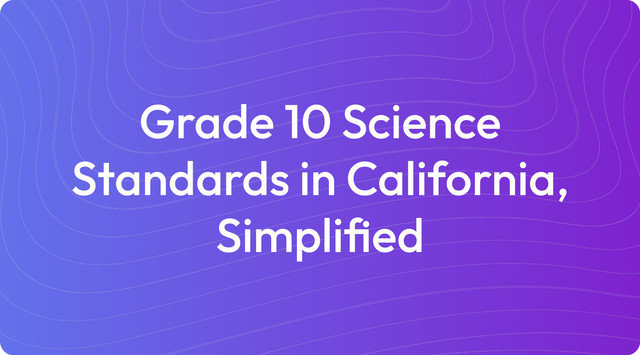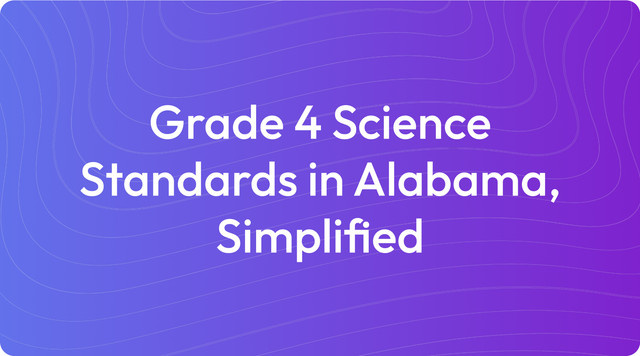Grade 2 Science Standards in Alabama, Simplified
Grade 2 science covers plants, animals, weather, and material changes in Alabama. For a quick overview, read more on TeachShare!
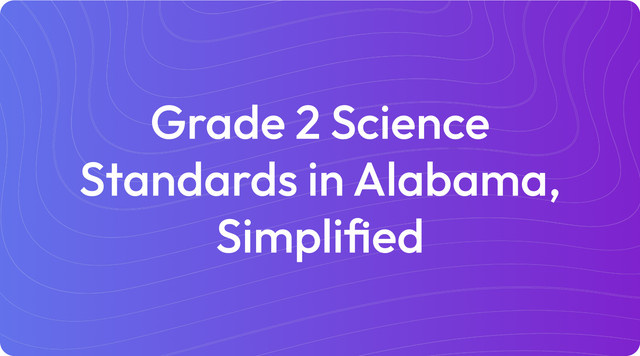
Education standards provide a roadmap for student learning, but turning them into engaging lesson plans can be a challenge for any educator. We recognize the need for clear, practical resources that connect these requirements to your classroom activities. Our goal is to offer support that helps you focus on what you do best: teaching.
Education standards are a set of learning goals that outline what students should know at each grade level. For teachers, they serve as benchmarks to guide curriculum planning, offering flexibility in how you teach the material. For example, Alabama's second-grade science standards require students to investigate if plants need sunlight to grow, giving you a clear objective for a science unit without prescribing the exact experiment.
What Are Grade 2 Science Standards in Alabama?
The Grade 2 Science Standards in Alabama, based on the Alabama Course of Study: Science (2015), focus on foundational concepts in Life Science, Physical Science, Earth and Space Science, and Engineering Design. These standards are built to encourage hands-on exploration and critical thinking, helping students connect science to the world around them and foster a genuine curiosity.
Key Areas of Grade 2 Science Standards in Alabama
1. Life Science (LS): Plants, Animals, and Habitats
- Plan and conduct an investigation to determine if plants need sunlight and water to grow.
- Develop a model that mimics the function of an animal in dispersing seeds or pollinating plants.
- Use information from observations to describe how animals and their offspring are alike and how they change as they grow.
2. Physical Science (PS): Properties of Matter and Simple Machines
- Plan and conduct an investigation to describe and classify different materials by their observable properties (e.g., color, texture, hardness, flexibility).
- Make observations and conduct experiments to determine how pushing or pulling affects the motion of an object.
3. Earth and Space Science (ESS): Earth’s Processes and Resources
- Observe and collect data on weather patterns over a period of time.
- Identify and compare the properties of natural sources of water, including rivers, lakes, oceans, and groundwater.
- Obtain information to identify where water is found on Earth and that it can be solid or liquid.
4. Engineering, Technology, and Applications of Science (ETS): Problem-Solving
- Use engineering practices to design a solution to slow or prevent water from changing the shape of the land.
Key Learning Goals for Grade 2 Science in Alabama
- Observation Skills: Students observe and describe patterns in weather, plant growth, and animal behavior.
- Hands-On Exploration: Students participate in experiments, investigations, and model-building to deepen understanding.
- Problem-Solving: Students engage in engineering challenges to design and test solutions to real-world problems.
The framework for these standards is guided by the Alabama Course of Study, which incorporates principles found in national topic arrangements for science education.
Key Tested Standards
The key tested standards for Grade 2 Science in Alabama, based on the Alabama Course of Study: Science (2015), emphasize critical skills across Life Science, Physical Science, Earth and Space Science, and Engineering Design. These standards assess a student's understanding of foundational concepts and their ability to engage in hands-on exploration and problem-solving.
1. Life Science (LS): Plants, Animals, and Habitats
- Standard 1: Plan and conduct an investigation to determine if plants need sunlight and water to grow.
Why It’s Key: This standard helps students understand the basic needs of plants and reinforces the scientific method. - Standard 2: Develop a model that mimics the function of an animal in dispersing seeds or pollinating plants.
Why It’s Key: This standard introduces students to the relationship between animals and plants and emphasizes how nature solves problems. - Standard 3: Use information from observations to describe how animals and their offspring are alike and how they change as they grow.
Why It’s Key: This standard helps students understand life cycles and the similarities and differences between parents and offspring.
2. Physical Science (PS): Properties of Matter and Motion
- Standard 4: Plan and conduct an investigation to describe and classify materials by their observable properties (e.g., color, texture, hardness, flexibility).
Why It’s Key: This standard encourages critical observation and classification skills, which are fundamental to scientific inquiry. - Standard 5: Make observations and conduct experiments to determine how pushing or pulling affects the motion of an object.
Why It’s Key: This standard introduces students to the basics of force and motion, preparing them for future concepts in physics.
3. Earth and Space Science (ESS): Earth's Processes and Resources
- Standard 6: Observe and collect data on weather patterns over a period of time.
Why It’s Key: This standard connects science to real-world observations, helping students understand patterns in weather and climate. - Standard 8: Obtain information to identify where water is found on Earth and that it can be solid or liquid.
Why It’s Key: This standard introduces the concept of Earth's water systems and the states of matter.
4. Engineering, Technology, and Applications of Science (ETS): Problem-Solving
- Standard 9: Use engineering practices to design a solution to slow or prevent water from changing the shape of the land.
Why It’s Key: This standard encourages problem-solving and creativity while introducing concepts like erosion and landforms.
Why These Standards Are Key for Testing
These standards are assessed because they emphasize critical thinking, scientific skills, and real-world connections, including:
- Observation and Investigation: Students learn to observe, collect data, and draw conclusions about plants, animals, weather, and motion.
- Model-Building: Students create models to explain scientific processes, such as pollination or erosion.
- Real-World Applications: Students explore concepts that connect to everyday life, like how weather changes or how materials are classified.
- Problem-Solving: Students engage in engineering challenges to design solutions to real-world problems, such as preventing erosion.
Sources: Next Generation Science Standards, Alabama State Department of Education.
Example Learning Objectives for Unit Planning
Learning objectives break down broad standards into specific, measurable goals for your students. They clarify what students should be able to do by the end of a lesson, helping you design focused activities and assessments. Below are examples of learning objectives for two Grade 2 Science standards, written in student-friendly language that aligns with the Alabama Course of Study: Science (2015).
Standard: Plan and conduct an investigation to determine if plants need sunlight and water to grow (Standard 1).
Learning Objectives:
- I can explain that plants need sunlight and water to survive and grow.
- I can set up an experiment to see how plants grow with or without sunlight and water.
- I can observe and record changes in plants over time during my experiment.
- I can use my observations to explain how sunlight and water help plants grow.
Standard: Make observations and conduct experiments to determine how pushing or pulling affects the motion of an object (Standard 5).
Learning Objectives:
- I can describe how a push or pull can make an object move, stop, or change direction.
- I can experiment with objects, like toy cars or balls, to see how they move when I push or pull them.
- I can explain how the strength of a push or pull changes how far or fast an object moves.
- I can use words or drawings to share what I learned about force and motion.
Key Changes & Updates
The Grade 2 Science Standards, based on the 2015 Alabama Course of Study, reflect a significant shift toward more dynamic, hands-on instruction. The focus is now on inquiry-based learning, where students actively participate in investigations and experiments, such as testing what plants need to grow. These standards also integrate engineering design principles, asking students to build models and design solutions for real-world problems like preventing erosion. This approach helps you connect abstract scientific concepts to tangible experiences, making learning more relevant and engaging for your second graders.
Beyond specific content, these updates emphasize the development of core scientific thinking skills. Students are encouraged to make careful observations, identify patterns in the natural world, and use evidence from their findings to form explanations. The standards also introduce systems thinking, helping students understand how different parts of an ecosystem or Earth system interact. By integrating math and literacy skills, such as graphing data and communicating results, these changes help build a strong, cross-curricular foundation for future scientific learning.
Create with TeachShare
Bringing these science standards to life requires creativity and time, resources that are often in short supply for educators. Our platform is designed to help you bridge that gap, offering AI-powered tools grounded in effective teaching strategies. Start creating standards-aligned instructional resources with TeachShare now.
Frequently Asked Questions
What are the main topics covered in Grade 2 Science in Alabama?
Grade 2 science in Alabama is built around four key areas:
- Life Science: How plants get what they need, the role animals play in pollination and spreading seeds, and the life cycles of animals.
- Physical Science: Exploring the properties of different materials and understanding forces like pushes and pulls.
- Earth and Space Science: Observing weather patterns, identifying natural water sources, and learning how water can change the land through erosion.
- Engineering Design: Applying scientific knowledge to design and test solutions for real problems.
What’s different about the Alabama science standards?
The Alabama Course of Study for Science (2015) shifts the focus toward a more active and applied approach to learning. Here’s what that looks like in the classroom:
- Hands-On Investigation: Students learn by doing, conducting experiments and actively exploring concepts.
- Real-World Connections: Lessons are tied to everyday experiences, making science relevant and understandable.
- Integrated Engineering: Students are encouraged to think like engineers by designing and building solutions to problems.
- Evidence-Based Thinking: The standards promote critical thinking by asking students to use evidence to support their conclusions.
What are some examples of activities aligned to Grade 2 standards?
Here are a few examples of classroom activities that bring these standards to life:
- Plant Needs: Grow plants under different conditions, such as with and without sunlight, to observe what they need to survive.
- Forces and Motion: Use toy cars and ramps to experiment with how pushes and pulls affect an object's movement.
- Weather Tracking: Have students keep a journal to record daily weather, helping them identify patterns over time.
- Erosion Prevention: Challenge students to design and build a structure that stops water from washing away sand or soil.
How do these standards connect to real life?
A key goal of these standards is to help students see science all around them. They learn practical concepts that explain:
- How plants and animals rely on each other for survival.
- Why weather forecasts are important for daily planning.
- How natural forces like water shape the environment and how we can manage those effects.
- How to choose the right materials for a specific job based on their properties.
How are students assessed in Grade 2 Science?
Assessment in Grade 2 science moves beyond traditional tests and focuses on what students can do. You can gauge understanding through:
- Direct Observation: Watching students as they conduct investigations and experiments.
- Data and Records: Reviewing the data they collect, such as weather charts or measurements from motion experiments.
- Projects and Models: Evaluating the models they build to demonstrate concepts like seed dispersal.
- Explanations: Listening to how students explain their findings and reasoning, whether through speaking, writing, or drawing.
Answer



